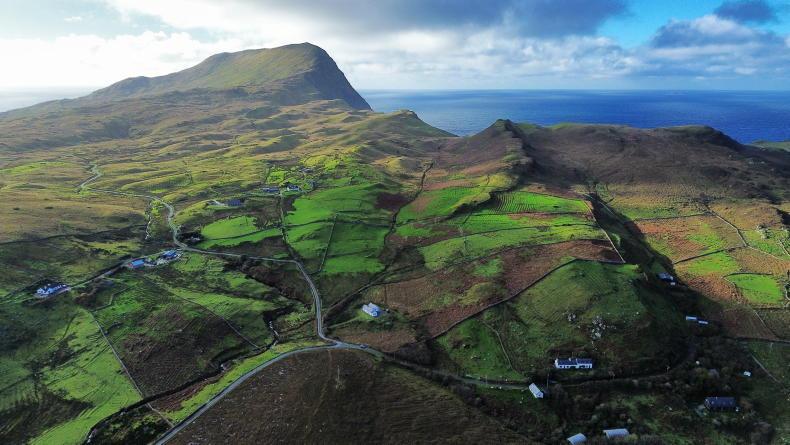Danny Healy-Rae was at his usual antics down at the National Ploughing Championships.“Greens out!” he shouted, restating his long-held position that there is nothing humans can do about climate change.
Danny Healy-Rae was at his usual antics down at the National Ploughing Championships.
“Greens out!” he shouted, restating his long-held position that there is nothing humans can do about climate change.
He is going to get a shock when Roderic O’Gorman and his green cabal leave the Government, and things continue to get worse for farming communities like his.
Climate change will continue to wreak havoc, farm viability will slide further and young people will choose not to stay around.
The inconvenient truth is that, without radical change, the prospects for many marginal beef and sheep farmers are bleak. This started long before the Green Party got into power.
With fewer people working the land, much of our uplands will revert to a wild state. In some places, they already have. I was at the Clonmany Agricultural Show over the summer.
The hills of Inishowen in the distance now have a distinctly fuzzy appearance, with thickets of heather, gorse, birch and bramble emerging.
Local farmers told me sheep have been off the hills there a few years now – it wasn’t deemed profitable any longer. While the uplands of Connacht and Munster are not quite there yet, the evidence for what’s coming is there for those willing to look.
This is not merely anecdotal. The most recent National Forest Inventory stated that while just 19,009ha of trees were planted in the period from 2017 to 2022, our woodlands grew by a total of 38,328ha. This can only be explained by the reproduction of wild trees, a process known as natural colonisation.
This withdrawal from marginal land shouldn’t surprise us.
Across the developed world as countries transition to modern economies, agriculture practised in the periphery begins to contract. This phenomenon has been observed from Japan to the US and is currently running rampant across many parts of Europe.
The Common Agriculture Policy (CAP) gave us a stay of execution in Ireland over recent decades.
Today, while there is arguably more CAP funding heading west of the Shannon, the drivers of abandonment (increasing economic opportunities outside farming, unreliable commodity markets, and relaxed rules on land eligibility) continue to strengthen and compound.
Cost of unmanaged withdrawal
Some advocates of rewilding may see this abandonment as the liberation of our uplands from the scourge of agriculture.
Indeed, an easing of extensive grazing pressure, particularly of sheep, will result in some positive ecological scenarios.
I have seen stunning emergent woodlands of rowan, birch and holly in south Kerry.
Head out west of Leenane on the road to Letterfrack for a sobering view into the future if things don’t change
However, there is another side to this coin. Without intention behind this process, species-rich grasslands will be lost, ground-nesting birds will be impacted, and thickets of rhododendron ponticum, lodgepole pine and giant gunnera rhubarb will envelop entire landscapes.
Head out west of Leenane on the road to Letterfrack for a sobering view into the future if things don’t change.
What’s frustrating is this needn’t be the case. There is great opportunity in these hills if leaders have the insight to see it, and the guts to build a different future around it.
At a Nuffield conference a few years ago, Nuffield Ireland president Geoff Dooley said: “We can’t keep managing land according to yesterday’s logic.” In much of the west, yesterday’s logic was that extensive grazing, assisted with the pressure valve of immigration, could just about sustain a population. This is no longer true.

In the outlying parts of our island a culture built around farming for thousands of years is fraying. With it will go music, the language, sport, etc, all the things that make these places so special. \ Ray O Foghlú
Today’s logic, primarily informed by the climate and biodiversity crisis, the true value in these hills is their vast carbon stores, their ability to buffer and filter rainfall, and to host rich and diverse natural habitats.
Change must come
Through their leadership, farmers must position themselves to benefit from, rather than suffer from new climactic, socioeconomic and regulatory realities.
Embracing change doesn’t mean giving up farming, in fact retaining functional farming communities is essential. Who else will maintain our species-rich grasslands? Restore our peatlands? Manage the invasive species?
Change should not scare these communities – agriculture has always changed. A century ago, sheep were a new thing in the mountains above Kilgarvan. Even 50 years ago, most people milked a few cows and kept pigs.
Change continues today, but it must accelerate and be coupled with a mindset shift.
Leaders such as the Healy-Raes or farm organisations like INHFA should be the ones seeking out and co-creating these new opportunities. Unfortunately, it’s not happening. I believe their heads – and lobbying positions – are still stuck in old-style headage payments for ewes and suckler cows.
Legitimate grievances
It must be acknowledged that the State hasn’t made it easy for farmers to see a bright future for themselves in nature restoration or climate action. Land designation without compensation severely damaged trust. Successively less enticing agri-environmental schemes have done further damage.
While these grievances should be acknowledged and made right, they are not an excuse for inaction. There is too much at stake.
With the right steps in place, it’s easy for me to imagine vibrant upland communities, where farming, forestry and nature restoration go hand in hand.
Now more than ever, leadership is needed.
Climate change will continue to impact farmers, regardless of what parties are in Government. Land abandonment happens globally when farm viability declines. Land abandonment is not good for habitats or communities. Leadership is required to show farmers a new future for their land.





SHARING OPTIONS: